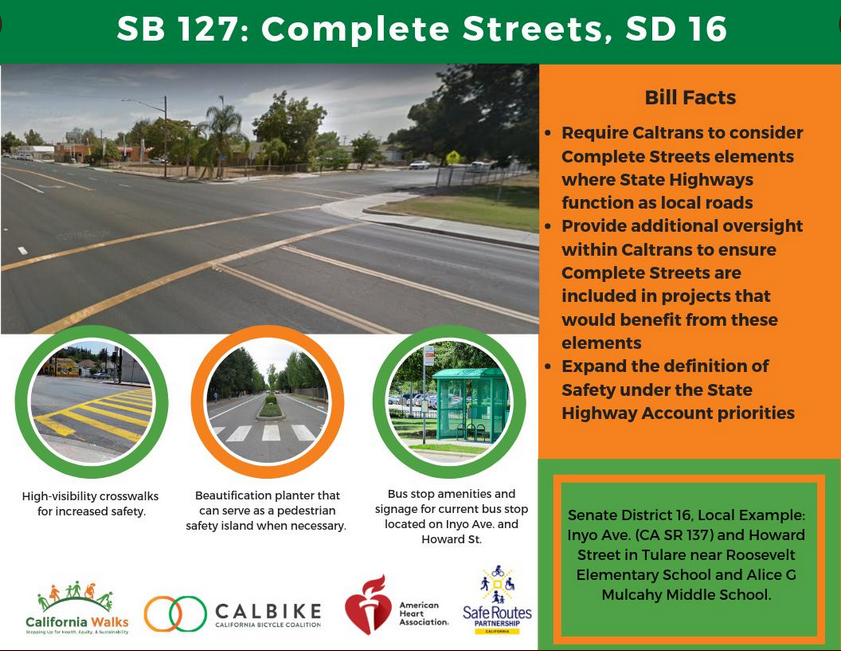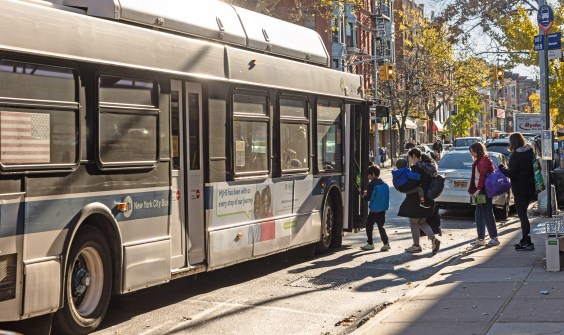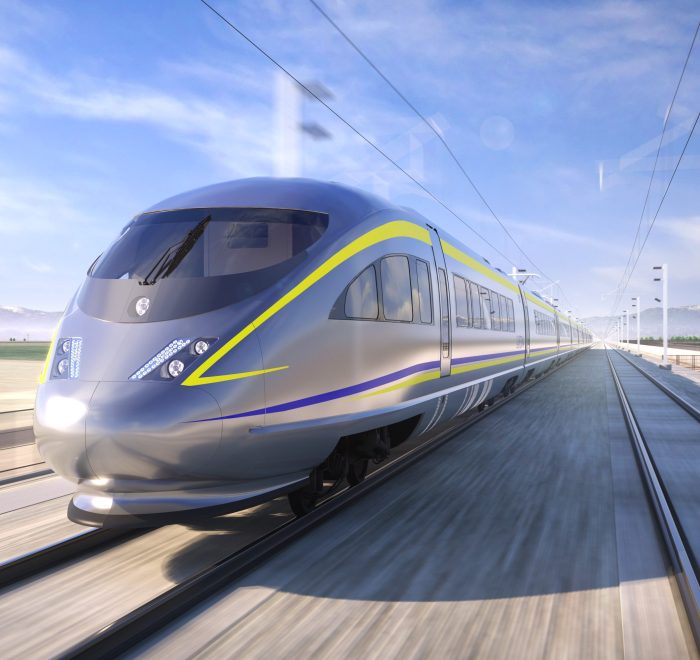Complete Streets Bill Threatened by Tardy, Unspecified, Absurd Cost Estimates
3:22 PM PDT on August 16, 2019

Would adding safety elements to this street, at the same time as ongoing repair, really cost $4.5m per mile, Caltrans?
The Complete Streets for All Bill, S.B. 127, has passed all the policy committees it needs to pass, and now sits awaiting its fate in the Assembly Appropriations Committee. S.B. 127 would require Caltrans to incorporate complete street designs--safety considerations for people on foot and on bikes--into road repair projects. It also requires Caltrans to track complete streets better, and assign employees specifically to do so.
Two things threaten the bill right now. First, the California Department of Finance just wrote a letter to the committee opposing the bill (read it here, as a PDF). The DOF weighs in on issues relating to money, and the Appropriations Committee's focus is on the fiscal impact of bills. The DOF analysis says the bill will cost too much. At the same time, it says the bill isn't necessary because the changes called for--incorporating "complete streets elements" into ongoing road repairs on state-owned highways in cities--are already happening. So--which is it? Is it too expensive, or is it already happening? Both can't be true.
Second, more than a year after the bill's author asked Caltrans for an estimate of how many highway miles might be affected by the bill and what it might cost, it finally coughed one up this week. Its estimate is, to put it simply, ridiculous.
Caltrans is claiming that S.B. 127 could cost California an extra $1 billion a year.
Yes, that's billion, with a B.
"With all due respect to Caltrans, this cost estimate is absurd," the bill's author, Senator Scott Wiener, told Streetsblog. "A price tag of more than a billion dollars on a bill that simply requires Caltrans to follow the policies it has already adopted--it just defies credibility."
"I'm saddened that they've done this," he added. "We've spent several years working with Caltrans on the bill. We've taken feedback and made amendments based on their feedback," he said. "But to come in now and put a price tag of more than a billion dollars--it's not credible," he said. "This rings of a department trying to sabotage a bill."
Caltrans estimates that this bill would add an extra $4.5 million per center line mile in costs to ongoing projects. Is this a reasonable amount? It seems awfully high for projects that add sidewalks or stripe bike lanes when a street is already being repaved. It's possible it could cost that much extra, if a project involves adding right of way, for example, but that's not what S.B. 127 calls for. And $4.5 million is almost certainly at the high end, not an average cost per project.
Is Caltrans padding its estimate? It would take someone with insider knowledge to pull apart these numbers, but Caltrans' late response has left little time to parse this.
But on top of all of this, Caltrans already has policies that require it to consider all road users when it repairs streets and roads--more on that below. S.B. 127's goal is simply to make it harder for Caltrans to ignore its own policies. How that could translate to an extra $1 billion a year is a logic that is difficult to follow.
"It's too expensive and it messes with S.B. 1"
Meanwhile, the Department of Finance analysis of the bill [PDF] concludes that it would "significantly increase state costs." The analysis neglects to include details about how the DOF arrived at its cost estimates--something which arguably should be its main subject, since this is addressed to a fiscal committee.
The letter adds:
Finance opposes this bill because it significantly increases state costs ....and makes it more difficult for the state to meet the goals outlined in Road Repair and Accountability Act of 2017 (S.B. 1, Beall, 2017).
This last part is simply not true. The goals of S.B. 1, which are many, include among them safety and complete streets. In fact, here's some of what the Road Maintenance and Rehabilitation Program is created to address, according to S.B. 1: "Complete street components, including active transportation purposes, pedestrian and bicycle safety projects, transit facilities, and drainage and stormwater capture projects in conjunction with any other allowable project."
Also this:
To the extent beneficial, cost effective, and practicable in the context of facility type, right-of-way, project scope, and quality of nearby alternative facilities, and where feasible,
...so many caveats, so many ways to get out of it...
the department and cities and counties receiving funds under the program shall incorporate complete street elements into projects funded by the program, including, but not limited to, elements that improve the quality of bicycle and pedestrian facilities and that improve safety for all users of transportation facilities.
"Safety for all modes of travel" is called for under other programs funded by S.B. 1 as well, including the Congested Corridors program--where safety is the top priority, above traffic congestion.
So: No, DOF, S.B. 127 would NOT make it more difficult to meet the state's goals under S.B. 1, and in fact lines up quite nicely with those goals.
"It's unnecessary"
Much of the DOF letter tries to make the case that S.B. 127 is unnecessary. "Caltrans already incorporates complete streets elements into projects when it is appropriate," writes the DOF. It lists the ways Caltrans has changed its ways: adopting a Complete Streets policy; creating and updating a Complete Streets Implementation Plan; adding Complete Streets elements to the Highway Design Manual; "committing to work with local agencies to look for additional opportunities to incorporate complete streets into its projects."
Good for Caltrans. Indeed, legislative and policy changes over the past five years or so do require Caltrans to address its previous neglect of road users outside of cars. Yet Caltrans does not automatically "incorporate complete streets elements into projects when it is appropriate."
"It's not doing these things," said Senator Wiener. "Caltrans has said for a long time that it wants to incorporate complete streets elements, but in practice it's not doing it. If the agency has the ability to, and says it want to, but doesn't do it, then legislation is completely warranted," he said.
A few examples: That recently completed, brand-new freeway overpass in Oakland for which Caltrans accepted accolades for incorporating complete streets elements but which is the opposite of safe or comfortable for people trying to use it on foot or bicycle. Another: On a new freeway overpass in Modesto, an important overcrossing for people on bikes and on foot, Caltrans engineers slapped on some sharrows at the last minute and called it a "complete street." There are undoubtedly many more examples of Caltrans' incomplete notion of what constitutes complete streets.
But, says the DOF, California is already investing plenty in active transportation modes. "The state's Active Transportation Program (ATP) dedicates $220 million per year to local entities for active transportation projects. ATP funding was nearly doubled in 2017 by S.B. 1, and the majority of ATP projects contain multiple complete streets elements," it writes.
To put that in perspective, the ATP receives less than two percent of overall state transportation funding, for modes that make up between one and four percent of total commute trips, but, with transit, up to twenty percent of total overall trips. Doesn't California want to encourage more trips by walking, biking, and transit? Why, yes, even Caltrans says so, in its own mission statement. Why yes, a key part of California's health and environmental goals involves getting people out of cars and onto their feet. Yes, indeed, and while new and safer street designs to encourage active transportation are being planned and built, the ATP does not give out anywhere near the amount of money that cities and counties and agencies ask for. Every year hundreds of projects apply for and go without funding because there isn't enough money in the ATP.
But it's also important to note here that "Complete Streets," as the DOF's analysis points out, are "a transportation facility that is planned, designed, operated, and maintained to provide safe mobility for all users, including bicyclists, pedestrians, transit vehicles, truckers, and motorists, appropriate to the function and context of the facility."
That is, a complete street is not just for bicyclists and pedestrians--it is ALSO for them.
ATP funds are appropriately spent on facilities for people engaged in active transportation. SHOPP funds are appropriately spent--should be spent--for the benefit of ALL road users.
"It's onerous"
At this point the DOF letter strays from the fiscal analysis it has neglected and takes a policy position. "This bill requires Caltrans to incorporate complete streets in all SHOPP projects located along certain types of state and local roads, or go through an onerous process to exempt the project from the requirement," it writes.
"Onerous" is a pretty freighted word. The bill in fact requires a single public hearing to discuss why Caltrans believes it can't deliver complete streets elements for a project. Is that more onerous than, say, Caltrans' own design exception process for cities wanting to try out new bike or pedestrian-safe designs?
It is certainly much less onerous than having to go back and make changes when it turns out that the finished repair is unsafe for people to use.
And, since this is a fiscal matter at this point, the DOF would have done well to note here that it is generally a lot less expensive to build something right the first time.
The analysis continues:
This bill will increase the cost of SHOPP projects significantly, and because transportation funding in California is limited, the bill will result in Caltrans completing fewer projects than currently planned.
[Choking sound] Fewer projects? The DOF is really starting to sound like a bullying group of NIMBYs or anti-BRT folks shouting every objection they can think of in the hope something will stick. The number of projects Caltrans completes has no bearing whatsoever on the quality of projects or the safety of projects or even the goals of S.B. 1. One big capital project could "result in Caltrans completing fewer projects." The goals of S.B. 1, to which the DOF analysis refers, include getting the highway system into a state of good repair to create a safe transportation system that everyone can use.
The number of projects is irrelevant.
Of course California wants to do the best it can with the money it has to invest. The relevant question should be: is the safety of all road users worth investing in? The DOF, like a cheapskate uncle, seems to think not.
Given the climate crisis we're facing, it's becoming very hard to maintain patience with those who insist that California should keep investing its money in making it easier for people to continue driving cars at the expense of everyone else. The Department of Finance analysts clearly think that's the right thing to do, and yet they don't even come out and say so. Maybe they need to pay more attention to Bill Nye.
S.B. 127 will be heard next Wednesday in the Appropriations Committee, which is chaired by Assemblymember Lorena Gonzalez (D-San Diego). It's likely that from there it will go to the "suspense file," which collects all the fiscal bills that need to be balanced against each other and the budget. The Appropriations Committee has until Friday, August 30 to decide the fate of those bills, at which point they are either moved forward to a vote on the floor of the house, held until next year, or die.
Follow Streetsblog California on Twitter @StreetsblogCal
Streetsblog California editor Melanie Curry has been thinking about transportation, and how to improve conditions for bicyclists, ever since commuting to school by bike long before bike lanes were a thing. She was Managing Editor at the East Bay Express, editor of Access Magazine for the University of California Transportation Center, and earned her Masters in City Planning from UC Berkeley.
Read More:
Stay in touch
Sign up for our free newsletter
More from Streetsblog California
Sudden State Funding Freeze Leaves Transit Agencies Hanging
Transit agencies were caught off guard by a 60-day funding freeze announced on the day they were expecting the allocations
Friday Video: How to Make Places Safe For Non-Drivers After Dark
A top Paris pedestrian planner, a leading GIS professional, and Streetsblog's own Kea Wilson weigh in on the roots of America's nighttime road safety crisis, and the strategies that can help end it.
Friday’s Headlines
Is your city safe for bicycling? Progress on CA high-speed rail; E-bikes are game changers; More
LAPD Was Crossing Against Red Light in Crash that Killed Pedestrian and Injured Six in Hollywood
The department says the officers had turned on their lights and sirens just before crossing. Their reasons for doing so remain unknown.
Wider Highways Don’t Solve Congestion. So Why Are We Still Knocking Down Homes for Them?
Highway expansion projects certainly qualify as projects for public use. But do they deliver a public benefit that justifies taking private property?




